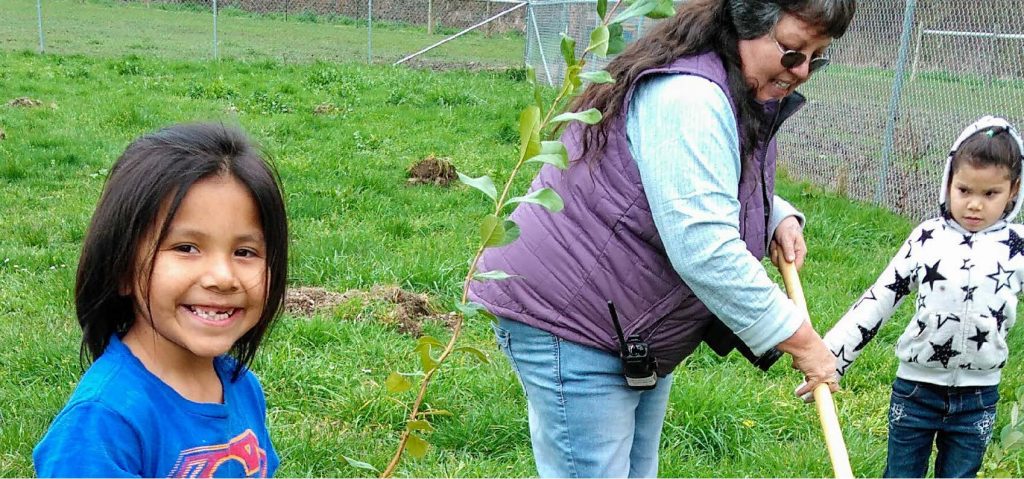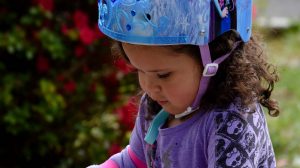Reading for health: A reimagined, community-driven approach to early literacy in Del Norte County and Tribal Lands
Monday, September 10, 2018In the downstairs den of Katie Creed’s Crescent City home, seven preschool-age children formed a scattered half-circle for afternoon story time. The room was an organized jumble of plastic bins overflowing with Legos, dolls, action figures, and other toys. Butterfly decals, Hello Kitty posters, and a large corkboard with photographs of children Creed has cared for covered the walls.
As Creed, a home-based child care provider, sat down to read, one of the children got up from the plush-carpeted floor and grabbed a chair to sit on. Suddenly, the other six followed suit.
Once the children were settled, Creed announced the title of the book to a chorus of approving cheer. The story, The Pout-Pout Fish in the Big-Big Dark, was a group favorite.
Seconds into the story, a wide-eyed little girl with curly blonde hair interrupted: “I don’t like big fish. Big fish eat you.”
“Sharks!” a young boy shrieked.
Creed continued with the story of the big fish that was scared of the dark.
“Are you guys scared of the dark?” Creed asked. The children nodded.
“I am, too, sometimes. But it’s OK. Your parents are there to keep you safe,” she said. “Shall we see what happens next?”
“The pirates got ’em!” said the boy who yelled “sharks!”
Creed was reading one of several books in the Wee Read School Readiness and Literacy curriculum, one of a myriad of efforts to improve early literacy in Del Norte County and Tribal Lands. The curriculum, which was designed by three community members, aims to improve kindergarten readiness with a specific focus on literacy.
“Before, I would read to them and just try to get through the story,” Creed said. “With these books, they connect the stories with their own personal stories. It makes them think and use their own imagination. I never thought about that concept and how beneficial it could be.”
 In Del Norte County and Tribal Lands, early literacy is more than a local educational effort. It is a major community-wide cause aimed at improving life outcomes and health, with strong support and involvement from residents, educators, and business leaders.
In Del Norte County and Tribal Lands, early literacy is more than a local educational effort. It is a major community-wide cause aimed at improving life outcomes and health, with strong support and involvement from residents, educators, and business leaders.
Early literacy first gained momentum as a community priority in 2009 when The California Endowment (TCE) selected Del Norte County and Tribal Lands among its Building Healthy Community sites. The 10-year, $1 billion community initiative launched by TCE in 2010 aims to “advance statewide policy, change the narrative, and transform 14 of California’s communities most devastated by health inequities into places where all people have an opportunity to thrive.”
Del Norte residents and representatives from local schools, businesses, and other stakeholders were initially charged with coming up with top community development priorities.
“A top priority was economic development,” recalled Geneva Wiki, TCE program manager in Del Norte. “I expected from the business community what they had been complaining about for decades: our infrastructure — improving our commercial harbor, the airport, sewer system. Surprisingly, they came to the conclusion that what needed to be fixed was the school system. Finding qualified workers had become a big challenge. Of course, we understood the connection between education and health.”
Del Norte: Spectacular scenery, devastated economy

Located adjacent to the Oregon border in the far northwest corner of the state, Del Norte County boasts spectacular scenery with dramatic rocky shorelines and towering Redwoods. But the postcard-perfect landscape belies the social and economic struggles that have plagued this community.
Del Norte County makes up part of what The New York Times in a recent article dubbed “California’s Great Red North, a bloc of 13 counties that voted for President Trump … and that make up more than a fifth of the state’s land mass but only 3 percent of its population … with a political ethos that bears more resemblance to Texas than to Los Angeles. Two-thirds of the north is white, the population is shrinking and the region struggles economically, with median household incomes at $45,000, less than half that of San Francisco.”
With a population of about 29,000 residents, which includes individuals incarcerated at Pelican Bay State Prison, Del Norte County is 73 percent white, 17 percent Latino, and nearly 8 percent Native American. The area was and is still inhabited mostly by the Tolowa Dee-ni’ and Yurok nations. The median household income in Del Norte is $29,642. About 20 percent of county residents are below the poverty line, including 26 percent of those under age 18.
“We were a lumber and fishing town. You could leave high school and support a family,” said Chris Howard, a member of the Del Norte Literacy initiative’s Schools Systems Implementation Team. “In the early 90s, the jobs and money disappeared. Soon, you not only saw the business community losing its tax base at a rapid pace, you saw social services ramping up, providing services for a population at a younger age.”
Meanwhile, businesses began seeing the economy’s impact on students’ educational achievement.
“We were losing half the kids before they got to be seniors,” Howard said. “That’s when we realized literacy had to be a priority. And the business community got right behind it. It was a perfect storm of this community’s focus on money instead of children. We forgot why we were fighting to get money. It was to reinvest in our children to become successful individuals in our community.”
Early literacy becomes a community focus
After the Building Healthy Communities team assembled a diverse group of local residents, the group came up with an overarching goal: Every young person in the county will graduate from high school ready for college. This resulted in the formation of the Schools Systems Implementation Team, a strategic partnership between BHC and the Del Norte Unified School District that worked to build a deeper understanding of the complexity of factors that impact a child’s capacity to learn and read by the third grade.
Around the same time, the group commissioned a kindergarten readiness assessment. “The data was bad,” Wiki said. “It showed 66 percent of our kids were not ready for kindergarten. As we learned more about what this meant, we learned how it was a strong indication of success or failure. For example, you could predict the prison population by how many kids were literate by the third grade.”
Early literacy is important for a number of reasons: 90 percent of brain development happens by age 5. Children need to be exposed to language in order to learn. A child’s vocabulary at age 3 is as a strong predictor of school success in the third grade and beyond.
The report served as a “wake-up call,” as Howard put it. “The bottom line was these kids read or go to jail. That’s when the community got involved in a big way. Parents and business leaders got involved. They turned over school board members. It was a turning point.”
 With help from a local philanthropy, the Wild Rivers Community Foundation, a volunteer tutoring program coordinated by the local United Way was organized to redress the literacy problem.
With help from a local philanthropy, the Wild Rivers Community Foundation, a volunteer tutoring program coordinated by the local United Way was organized to redress the literacy problem.
“The thought at the time was it’s a best practice. We can scale it out, and it’ll solve the problem,” recalled Jeff Harris, who became Del Norte Unified School District superintendent in 2015 after the community began demanding changes in school district priorities and leadership. “It didn’t work. Why? Because we weren’t getting to the root problem. We really didn’t understand what these kids and families were going through at home, and what the true barriers were.”
Shortly after, Harris joined the School Systems Implementation Team. At the same time, Harris began learning about ACEs (adverse childhood experiences). This foundational research has shown how childhood experiences, both positive and negative, have an impact on future violence victimization and perpetration, along with lifelong health and opportunity.
“I’m a data guy. I said, ‘Let’s not prescribe something until we know what the illness is,'” Harris said. “There had been lots of intervention efforts and blame assessed. When we asked what the story behind the data was, that’s when we got the root of the problem.”
Empathy approach reveals root problems, challenges

With a specific goal of 100 percent of third-graders in Del Norte and Tribal Lands reading at grade level — double the current level — the School Systems Implementation Team set out to gather the stories from educators and families using empathy-based research methods and synthesis.
“We asked them to tell us about their day. About their life. What was the highest hope they had for their kid?” Wiki recalled. “We got a better picture of the serious levels of stress and pain that families were going through. We found a lot of families felt disconnected from their network of support. Many can’t rely on extended family members.”
They also found a number of families could not find the time to prepare their young children for school because many were working two jobs to make ends meet. Some simply didn’t understand what school readiness was. “We had a lot of people asking, ‘What am I supposed to do to get my child ready for preschool?'” Wiki said.
“It was a transformational experience for everyone,” she added. “The old model was, ‘We know what’s best for you.’ We weren’t talking to the people impacted. It was getting out of sympathy to empathy: I feel and understand your pain.”
The research team talked to parents in their homes and asked to take them on a learning tour to show them where their children read, played, and did homework. In some cases, it was the children themselves who took the interviewers on the tour.
Families and other community members responded to the interviews with appreciation and pledges of support.
“The feedback we heard was, ‘You’re not saying come to my meeting or fill out this survey. You came into our homes and asked us about our lives,'” said Gary Blatnick, former director of Del Norte County Health and Human Services. “I don’t care if you’re in downtown Oakland or Klamath, anti-poverty and education work involves talking to people.”
While early literacy emerged as a top priority with a clear goal, the home visits and interviews revealed unique challenges for Del Norte — along with a few surprises.
“It was surprising that most families had books in their homes,” Harris said. “It was how these families were engaging in their child’s reading that was the missing piece. And it was obvious we were going about solving the problem in the wrong way. Before we thought, ‘Let’s put more books in the home. Let’s get more tutors to help kids read.’ We weren’t thinking about how to engage families in the education of their kids and what those true barriers were.”
Harris and others observed through the home visits that simply having books available to children wasn’t enough. Having parents read to their children, talk about the lessons in the stories, and become engaged in other ways was an important part of their children’s literacy development.
One of the key insights that emerged from the empathy research with parents was the lack of understanding of the importance of early literacy and what it means to be prepared for kindergarten.
One parent who expressed similar concerns brought up another challenge many parents face: not enough support in getting their children school-ready. “I want my children to be successful and to have a better life,” the parent said. “I don’t always know what that looks like or how to help them get there. Even when I know how to help my children, I don’t often have the time or resources to do so.”
Altogether, the team interviewed 27 families and 11 educators.
Afterward, “everyone was pulled together for a community vision,” Wiki said. “According to the beliefs of our Native community, this is the land of plenty. The Tolowa creator created everything we need. There needs to be a shift in narrative from hopelessness to plenty.”
For Chrystal Helton, a parent from Klamath who became actively involved in the community after being part of the empathy interviews, the Tolowa legend resonates deeply.
“Is this a food desert? No. But we’ve lost our connection to the bounty — that connection with nature, that feeling you have that gives you purpose. Those are good motivators to keep our children and families moving forward,” said Helton, who is of the Ojibwe tribe.
“Our kids are completely different. They have different needs,” Helton said. “They’re not coming to school fed, bathed, and ready to learn. We’re isolated and disengaged. I tell people to get involved, to be part of the process. Disengagement and literacy is a problem. People need to understand that’s what divided us, divided our tribes.”
Clearly defined targets, early successes
The overall goal-setting and empathy exploration were the first two of six co-design stages that actively involved the community, including families, educators, schools, and early child care providers. Next, they defined the change they wanted to see, generated ideas for initiatives that would effect change, co-designed initiatives together, and, finally, implemented and scaled the new initiatives.
To achieve their goal of 100 percent of third-graders in Del Norte and Tribal Lands reading at third-grade level by 2023, the Del Norte Literacy initiative identified a number of specific targets: Increase preschool participation from 20 to 100 percent; improve access to quality child care from 33 to 100 percent; improve kindergarten readiness from 33 to 95 percent; and increase access to preschool slots from 50 to 75 percent for income-eligible 3- and 4-year-olds.
The set of projects to reach their targets are numerous and wide-ranging. They include some novel co-design approaches, such as the Un-homework initiative, which calls for homework policies to eliminate lengthy homework assignments requiring time commitments from parents and to include experiential activities that encourage quality family time. A new Parent Connections Texting initiative helps parents to be more connected to the resources they need to help their children get ready for kindergarten. And a Stress Buster initiative seeks to lower children’s levels when they’re at school and promote learning.
The community-wide effort has already yielded results. For example, with the help of a state Department of Education Early Head Start Partnership Grant, the Del Norte Child Care Council has nearly doubled the number of home-based child care providers offering quality programs, from 33 percent to 62 percent. The council has worked closely with the Del Norte Literacy initiative to improve reading levels.
In addition, the number of preschool slots for income-eligible 3- and 4-year-olds have increased.
For leaders in the effort, early child care providers such as Creed, who continues to provide developmentally stimulating care to local children, are a crticial part of Del Norte’s success. Instead of working in their own silos and looking at their own data, early child care providers along with local supporting agencies and the school district are now setting shared goals and collaborating on systems and policy changes that are making an impact on children and families.
Lessons learned

The Del Norte Literacy initiative has been a learning as well as transformational experience for the community as a whole. Challenging long-held, false assumptions about problems with early literacy was only the beginning. A few key lessons learned include:
Maintain transparency. From the start, the Del Norte Literacy initiative has ensured transparency by building partnerships with local community members, business leaders, educators, and others stakeholders. Keeping stakeholders informed of the initiative’s process as well as progress has been key, beginning with a community-wide Literacy Symposium held in June 2016.
Measure progress. In addition to supplying critical baseline data, measurement protocols have also allowed for progress reports that have provided hope and momentum. Measurement also helps to identify projects that can bring about the changes being sought, and to establish the leadership and programs to deliver those projects.
Keep civic engagement authentic. The team accomplished authentic civic engagement in several ways. First, to meet its goal, the Del Norte Literacy initiative used a co-design approach that actively involved the community throughout the different design stages. Empathy research based on interviews with families, children, educators, and child care providers allowed initiative supporters to understand and make sense of the experiences of those interviewed.
Use data wisely. In Del Norte, data became an exploratory rather than a prescriptive tool. Educators and others learned a valuable lesson when they discovered that putting more books in homes and hiring tutors to help improve early literacy scores was the wrong approach. They needed to find ways to get families more involved in their children’s early education.
Cultivate and develop existing resources. Home-based child care providers make up a huge part of Del Norte’s “front line” in the fight for early literacy. By helping these providers improve the quality of their care, Del Norte has already seen increases in school readiness.
Build trust. The Schools Systems Implementation Team, the strategic partnership between Building Healthy Communities and the Del Norte Unified School District, emphasized the importance of trust. Because earlier efforts to address childhood literacy in Del Norte lacked trust and relationship-building, those solutions fell short. Once the community was able to establish trust through authentic engagement and years of dedication to a common purpose without resorting to finger-pointing and blame, workable solutions emerged.
Vision for the future: Next steps for Del Norte Literacy initiative

The future roadmap for Del Norte Literacy initiative calls for “action learning pit stops,” or planned sessions of the initiative’s core design team to share and coordinate their various projects. The pit stops will look at each project and ask: What is working well and why? What could be improved? What are the biggest challenges? What are the resourcing opportunities and gaps? The team will then identify what they need to keep doing, what they need to amplify, and what they need to stop doing.
The next test-and-learn phase will formalize evaluation tools and, like this report, tell the story of change in Del Norte. The next step for the core design team will be to come together again to evaluate projects and plan what should be embedded and scaled.
There is an overall consensus in Del Norte that the vision for the future is hopeful — for children, families, educators, and local businesspeople like Kevin Hartwick.
“Maybe we lost a generation or two. But we have the opportunity to work on the now. Build — rebuild something now for the future,” said Hartwick, an accounting firm manager and member of the initiative’s School Systems Implementation Team. “People got a taste of what success feels like. A lot of us truly believe there’s more to come.”
Acknowledgments
This case study was written by BMSG’s Fernando Quintero.
BMSG would like to thank the following reviewers for their valuable feedback and edits: Alexandra Desautels and Kate Shea, The California Endowment; and Geneva Wiki and Michelle Carrillo, The California Endowment, Building Healthy Communities, Del Norte and Tribal Lands. Thanks also to The California Endowment for their generous support of this project.
© 2018 Berkeley Media Studies Group, a project of the Public Health Institute, and The California Endowment.




